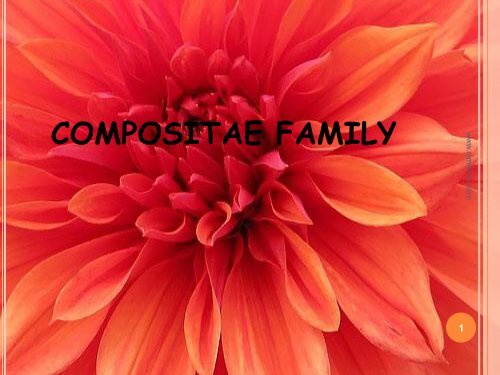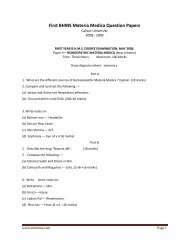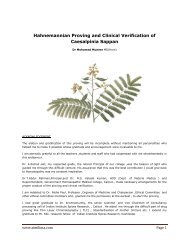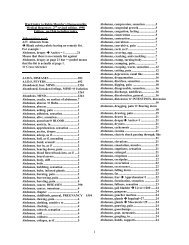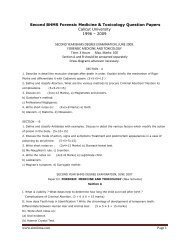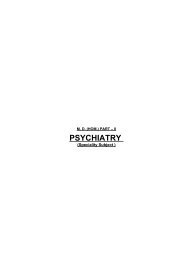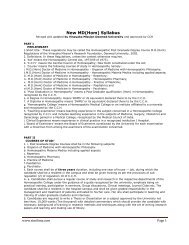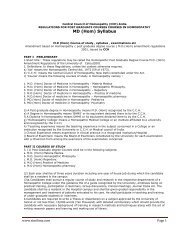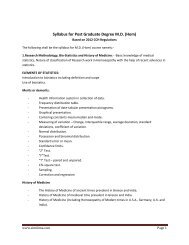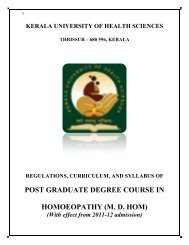Compositae family remedies - Similima
Compositae family remedies - Similima
Compositae family remedies - Similima
You also want an ePaper? Increase the reach of your titles
YUMPU automatically turns print PDFs into web optimized ePapers that Google loves.
COMPOSITAE FAMILY www.similima.com<br />
1
ASTARACEAE<br />
(ASTER FAMILY)<br />
SUNFLOWER/DAISY<br />
FAMILY<br />
2<br />
www.similima.com
� It is one of the biggest<br />
<strong>family</strong> in our<br />
materiamedica. There<br />
are 60 <strong>remedies</strong><br />
mentioned in our MM.<br />
� They are annual or<br />
perennial herbs,<br />
shrubs and rarely<br />
trees.There are 900<br />
genera & 19000<br />
species of this <strong>family</strong><br />
www.similima.com 3
� Uniqueness of <strong>family</strong> is what appears to be a<br />
single flower is actually composite of many<br />
florets. Hence the name of the <strong>family</strong> is<br />
compositae.<br />
� These florets are arranged in disc like flower<br />
head or receptacle in centripetal manner<br />
enclosed in involucres of whorled bracts of<br />
modified leaves<br />
� Flowers of compositae is of many individual<br />
florets, which are of two types Regular or Disc florets<br />
Irregular or ray florets- disc florets form the central disc of<br />
short flower and ray florets form outside petals<br />
4<br />
www.similima.com
Active principles<br />
� Hydrocarbons, alcohols,phenolic ester, acetone,<br />
acids, esters, sugars, starch, resinoid,<br />
glucosides, alkaloids<br />
www.similima.com 5
IMPORTANT REMEDIES OF THE<br />
GROUP<br />
1. Injury group<br />
2. Convulsion group<br />
3. GIT& GUT group<br />
4. Cichoriaceae <strong>family</strong><br />
5. Fever group<br />
www.similima.com 6
INJURY GROUP<br />
1. Arnica montana<br />
2. Bellis perenis<br />
3. Calendula officinalis<br />
4. Cineraria maritima<br />
5. Erigeron<br />
canadensis<br />
6. Achiller millefolium<br />
www.similima.com 7
CONVULSION GROUP<br />
1. Artemisia Abrotanum<br />
2. Artemisia Absinthium<br />
3. Artemisia vulgaris<br />
4. Cina maritima (Artemisia maritima)<br />
5. Chamomilla.<br />
6. Tanacetum vulgare<br />
www.similima.com 8
GIT & GUT GROUP<br />
1. Brachyglottis<br />
2. Cardus marianus<br />
3. Cardus benedictus<br />
4. Senecio<br />
5. Senecio Aureus<br />
6. Gnaphalium<br />
7. Inula<br />
8. Solidago<br />
9. Tussilago Farfara.<br />
10. Tussilago Fragrans.<br />
11. Tussilago petasites<br />
www.similima.com 9
CICHORIACEAE GROUP<br />
1. Cichorium<br />
2. Lactuca virosa<br />
3. Taraxacum *<br />
4. Liatris spicata<br />
5. Lapsana communis<br />
www.similima.com 10
FEVER GROUP<br />
1. Eupatorium Aromaticum.<br />
2. Eupatorium Perfoliatum.<br />
3. Eupatorium Purpureum<br />
4. Helianthus Annus .<br />
5. Parthenium Hysterophorus .<br />
6. Pyrethrum Parthenium.<br />
www.similima.com 11
OTHER IMPORTANT REMEDIES<br />
1. Echinaceae Angustifolia.<br />
2. Echinaceae Purpurea<br />
3. Wyethia.<br />
4. Grindelia.<br />
5. Guaco.<br />
12<br />
www.similima.com
SPHERE OF ACTION AND PATHOPHYSIOLOGICAL<br />
ACTION<br />
� 1) blood- relaxation & weakening of capillary vessels<br />
stasis extravasation capillary oozing,<br />
ecchymosis, internal haemorrhage<br />
� 2) muscles & soft connective tissue inflammation<br />
SORE, LAME, BRUISED FEELING<br />
13<br />
www.similima.com
� 3)MM of GIT, GUT, RS---- Inflammation with exudation<br />
and soreness congestion<br />
discharge with bleeding<br />
� 4)CNS ---- Congestions CONVULSIONS<br />
� 5)Glands-- Inflammation induration<br />
� 6)Joints ---Inflammation rheumatism<br />
� 7) Skin ---Inflammation suppuration<br />
� 8) Nerves--- injuries Inflammation<br />
intense pain with soreness<br />
� 9) Female reproductive system--- Uterinemuscles<br />
atonic condition haemorrhage<br />
10) Heart Hypertrophy<br />
14<br />
www.similima.com
GENERAL MENTAL FEATURES OF COMPOSITAE<br />
� Mental irritability<br />
� Nervousness, excitability, fidgety<br />
� Hysterical tendency<br />
� Sadness, mental depression<br />
� Sensitive to effect of recent or past trauma<br />
� Fear of accidents or dead bodies<br />
� Anxious dreams with restless sleep<br />
� Contradiction intolerable<br />
� Kleptomania- art vul<br />
� Somnambulism- art vul<br />
� Child- ill natured, spiteful, uncivil, cruel, peevish, irritable,<br />
poor concentration<br />
15<br />
www.similima.com
Causative factors or basic feeling which is responsible<br />
for these expressions<br />
1)Most of plants are weeds growing on unwanted places without any care<br />
2)Chicory plant- bach flower remedy- said that behavioural disturbance<br />
come from “extreme uncared for, unwanted, rejected feeling”. In cina<br />
,cham etc we can see this.<br />
3) But they adopt other measures to get that love,warmth, care etc in the<br />
form of capriciousness, unruly, ugly behaviour with strong> by being<br />
carried or by hysterical & self centered<br />
4)Another consequence is they lacks self identity, or sense of belonging or<br />
connectedness and therefore easily affected by external forces producing<br />
fear of attack, fright , anxiety OR complete disconnectedness, tells no<br />
complaints even if he is seriously ill, or comatose stages<br />
16<br />
www.similima.com
COMMON PHYSICAL FEATURES<br />
1. Acute and chronic effects of trauma<br />
2. Hypersensitivity- out of proportion to affection<br />
3. Sore, lame ,bruised feeling of affected parts<br />
with restlessness<br />
4. Ecchymosis, internal bleeding and<br />
haemorrhagic tendency<br />
5. Nervous affections- convulsions and epilepsy<br />
6. Septic fever with delirium and pseudo euphoria<br />
7. Marasmus- ascending type in spite of ravenous<br />
appetite<br />
8. Thirsty<br />
9. Used for worm troubles<br />
17<br />
www.similima.com
10) Affections of children – convulsions,<br />
dentition problems, worm troubles,<br />
emaciation, irritability etc<br />
11) Generally left sided affections .<br />
12) Complaints associated with coldness.<br />
13) Marked action upon the blood , muscular fibres<br />
of the bloods vessels -- venous congestion and<br />
haemorrhagic tendency.<br />
14)Action upon the respiratory mucus membrane –<br />
causing allergic manifestations, dyspnoea and<br />
whooping cough; exudative processes<br />
15) Predominant action on liver and spleen<br />
16) Rheumatic affections<br />
18<br />
www.similima.com
17)Most of the <strong>remedies</strong> of this group is useful in<br />
cancerous affections.<br />
Abrotanum: prevents metastasis. Angioma of<br />
the face.<br />
Calend: As an intercurrent remedy in cancer.<br />
Cardus m: rectal cancer with profuse diarrhoea.<br />
Echi: Tendency to malignancy in acute and<br />
subacute disorders. Last stages of cancer to<br />
ease pain .<br />
Guaco: Cancer<br />
Senecio jacoboea: cancer<br />
Tarax : Cancer of bladder.<br />
18)Marked action on skin, eyes, urinary system<br />
19<br />
www.similima.com
� GENERAL MODALITY<br />
� Aggravations<br />
Touch, jar, motion, damp cloudy weather, cold air, injury,<br />
drinking,evening, night, music and suppressed<br />
discharges. Sensitive to cold open air<br />
� Ameliorations<br />
Continued motion, rest, lying on abdomen, better after<br />
discharge, profuse sweating,<br />
20<br />
www.similima.com
� Common features of Injury group<br />
1) Ill effects of injury, recent or remote, and injury<br />
in any form<br />
Eg: arnica- bad effects of blunt, external injury or<br />
falls<br />
Cal- injury due to cuts and lacerations<br />
Bellis perenis<br />
< deep trauma, travelling , fall<br />
� 2) injury to muscles, connective tissue, joints mainly<br />
causing –inflmn<br />
� --sepsis/suppuratio<br />
� --rheum<br />
� -- tumours<br />
� --miscarriage<br />
22<br />
www.similima.com
3) injured nerves produce extreme painfulness ,<br />
SORENESS, ACHING, BRUISED SENSATION<br />
< slightest touch, motion, being approached suggests vary<br />
sensitive , painful state<br />
4)Weak & relaxed vessels of deeper organs that they<br />
produce profuse he, ecchymosis & varicose veins<br />
5) Overuse of any organ, excess sexual indulgence<br />
produce deep seated affections<br />
23<br />
www.similima.com
6) Mind<br />
A/F accidents, injuries<br />
Loosing harmony<br />
- A state of fear, fright,nervousness, sleeplessness,or<br />
nightmares after accidents, injuries. Fear of being<br />
approached or touched<br />
- Absolute confusion, depression, sadness, good for<br />
nothing feeling or loss of ambition, he does not know<br />
what to do, declares himself well when he is seriously ill<br />
- COMPLETE DEPRESSION AND DISSOCIATION FROM<br />
REALITY<br />
24<br />
www.similima.com
ARNICA MONTANA<br />
� - Leopard's-bane.<br />
� Wolf’s eye<br />
� - Fallkraut. (german)<br />
� - Tincture of whole<br />
fresh plant before just<br />
flowering/<br />
� - Tincture of root.<br />
www.similima.com 25
� Arnica is the king of our traumatic <strong>remedies</strong>.<br />
� Its essential oil contains an imperfectly known<br />
alkaloid called Arnicin, and a starchy substance<br />
known as Inulin.<br />
� For the bad effects resulting from mechanical<br />
injuries; even if received years ago.<br />
� - Sore, lame, bruised feeling all through the body,<br />
as if beaten; traumatic affections of muscles.<br />
� - Mechanical injuries, especially with stupor<br />
from concussion; involuntary faeces and urine.<br />
� - After injuries with blunt instruments (Symph.).<br />
26<br />
www.similima.com
� - Concussions and contusions, results of shock or injury;<br />
without laceration of soft parts; prevents suppuration<br />
and septic conditions and promotes absorption.<br />
� - Nervous, cannot bear pain; whole body oversensitive<br />
(Cham., Cof., Ign.).<br />
� - Says there is nothing the matter with him.<br />
� Dysentery; with ischuria, fruitless urging; long interval<br />
between the stools.<br />
� ribbon-like stools from enlarged prostate or<br />
retroverted uterus.<br />
� - Retention or incontinence of urine after labor (Op.).<br />
27<br />
www.similima.com
Dr.SK. Banerjea delineates the totality through the common<br />
name of medicine Leopard's Bane.<br />
� L =Lame sore bruised feeling all through the body.<br />
� E = Everything hard : complaints constantly of it.<br />
� O = Oversensitive : nervous cannot bear pain.<br />
� P = Painful boils: one after another.<br />
� A = After-effects of injury: even if received years ago.<br />
� R = Ribbon-like stools.<br />
� D = Dysentery with ischuria.<br />
� S = Soreness of parts after labor.<br />
� B = Belching: foul putrid like rotten eggs.<br />
� A = Apoplexy: with loss of consciousness.<br />
� N = Nothing the matter with him.<br />
� E = Erect walking impossible: excessive fear of being<br />
touched.<br />
28<br />
www.similima.com
Calendula officinalis.<br />
Marigold.<br />
Tincture of leaves and<br />
flowers.<br />
29<br />
www.similima.com
� Traumatic affections : to secure union by first<br />
intention and prevent suppuration.<br />
� - External wounds with or without loss of<br />
substance; torn and jagged looking wounds;<br />
post-surgical operations; to promote healthy<br />
granulation and prevent excessive suppuration<br />
and disfiguring scars.<br />
� - Calendula is almost specific for clean, surgical<br />
cuts or lacerated wounds, to prevent excessive<br />
suppuration.<br />
30<br />
www.similima.com
BELLIS PERENNIS<br />
� Daisy.<br />
� Wound wort,<br />
� bruise wort<br />
www.similima.com 31
� - It is especially useful in deep trauma or septic wounds of<br />
abdominal and pelvic organs; after major surgical<br />
operations.<br />
� - It removes the ill effects of auto-traumatism - excess of<br />
masturbation.<br />
� - It acts upon the muscular fibers of the blood-vessels. It<br />
affects Blood Vessels causing venous stasis, and varicose<br />
veins.<br />
� - Injuries to the nerves, with intense soreness amel. by cold<br />
bathing.<br />
� - Muscles become SORE AND BRUISED.<br />
� - It is a suitable remedy to old labourers, and commercial<br />
travellers.<br />
� - Near and remote effects; of blows, falls, accidents, railway<br />
spine.<br />
� - Tumours from injury.<br />
32<br />
www.similima.com
ACHILLIS MILLEFOLIUM .<br />
� Achillea millefolium.<br />
� - Yarrow.<br />
www.similima.com 33
� Ailments: from over-lifting, over-exertion, or a fall.<br />
� - Haemorrhages: painless, without fever<br />
� - Haemoptysis: after injury; in incipient phthisis;<br />
in haemorrhoidal patients; from a ruptured blood<br />
vessel.<br />
� - Leucorrhoea of children from atony (Cal.).<br />
� - Cough: with raising of bright blood; in<br />
suppressed menses or haemorrhoids; with<br />
oppression and palpitation; after a fall from a<br />
height (Arn.); after violent exertion; with blood;<br />
daily at 4 P.M. (Lyc.).<br />
� -Follows well: after, Acon. and Arn. in<br />
haemorrhages.<br />
34<br />
www.similima.com
CINERARIA MARITIMA<br />
� Dusty Miller.<br />
� Habitat- Venezuela<br />
and other parts of<br />
tropical America.<br />
�<br />
www.similima.com 35
� Has some reputation in the cure of cataract<br />
and corneal opacities.<br />
� * Is used externally, by instilling into the eye<br />
one drop four or five times a day.<br />
� * This must be kept up for several months.<br />
� * Most effective in traumatic cases.<br />
36<br />
www.similima.com
ERIGERON CANADENSIS<br />
� - Canada Flea-bane.<br />
www.similima.com 37
� Haemorrhages are caused and cured by this remedy.<br />
� * Persistent haemorrhage from the bladder.<br />
� * Haemorrhage from the uterus, with painful micturition.<br />
� * FEMALE:-<br />
� - Bright-red flow.<br />
� - Menorrhagia; profuse leucorrhoea; bloody lochia<br />
returns after least motion, comes in gushes; between<br />
periods, leucorrhoea with urinary irritation; pregnant<br />
women with "weak uterus;" a bloody discharge on slight<br />
exertion.<br />
� - Bleeding haemorrhoids; nosebleed instead of menses.<br />
[Bry.]<br />
38<br />
www.similima.com
Common features of Convulsion group<br />
1)Chiefly affect BRAIN, MEDULLA & SPINE<br />
2)convulsion, epilepsy, convulsive diseases of<br />
childhood<br />
3)Convulsions with trembling, biting of tongue,<br />
tremors, chorea, opisthotonous, giddiness, there<br />
may or may not be loss of consciousness<br />
4)They are all childrens remedy- emaciation<br />
inspite of eating well, worms, convulsions,<br />
emotional and temperamental oversensitivity<br />
39<br />
www.similima.com
5) Children- Are cross:- irritable, very TOUCHY,ugly in<br />
behaviour, dissatisfied, capricious, & children DO NOT<br />
WANT TOBE TOUCHED OR LOOKED AT.<br />
6) Modalities<br />
< cold, night, touch, anger , vexation<br />
> MOTION<br />
This modality found in all convulsion gr.<br />
Cham & cina relief from motion<br />
Artemisia has desire to move about<br />
Absinthinum- due to delirium pt is obliged to walk about<br />
40<br />
www.similima.com
CINA MARITIMA(ART MAR)<br />
� The unexpanded flower-heads (commonly called<br />
"seeds") of several varieties of Artemisia maritima.<br />
� - Semen cinae.<br />
� - Flores cinae.<br />
� - Wormseed.<br />
Alkaloid-santonine- strong antihelminthic- esp round<br />
worms<br />
41<br />
www.similima.com
42<br />
www.similima.com
� * Pain in shocks.<br />
� Adapted to children with dark hair, very cross,<br />
irritable, ill-humored, want to be carried, but<br />
carrying gives no relief; does not want to be<br />
touched<br />
� Constantly digging and boring at the nose; picks<br />
the nose all the time.<br />
� - Children, suffering from worms,grinding of<br />
teeth (Cic., Spig.); ascarides (Teucr marum<br />
verum).<br />
43<br />
www.similima.com
� - Face is pale; sickly with dark rings under the<br />
eyes; one cheek red, the other pale (Cham.).<br />
� - Canine hunger : hungry soon after a full meal;<br />
craving for sweets. refuses mother's milk.<br />
� - Cough : dry with sneezing; spasmodic, gagging<br />
in the morning.<br />
� - Child is afraid to speak or move for fear of<br />
bringing on a paroxysm of coughing (Bry.).<br />
� Bedwettting< fullmoon<br />
44<br />
www.similima.com
CHAMOMILLA<br />
45<br />
www.similima.com
� Matricaria chamomilla.<br />
� Chamomilla is particularly suited to diseases of<br />
pregnant women, nurses and little children.<br />
� Especially of frequent employment in diseases of<br />
children, where peevishness, restlessness and colic<br />
give the needful indications. The senses are too<br />
acute. Hypersensitive to pain<br />
46<br />
www.similima.com
� - Children, new-born and during period of dentition.<br />
� - Child quiet only when carried.<br />
� - Complaint from anger, especially chill and fever.<br />
� Mental calmness contraindicates Chamom.<br />
� Convulsions of children from nursing, after a fit of<br />
anger in mother (Nux. after fright in mother, Op.).<br />
� Puerpural convulsions after anger<br />
� Pain : with numbness of affected part.<br />
� Toothache if anything warm is taken into the mouth<br />
(Bis., Bry., Coff.); during menses or pregnancy.><br />
cold water<br />
47<br />
www.similima.com
ARTEMESIA ABROTANUM<br />
Lady's Love.(lad’s love)<br />
Southernwood.<br />
(Southern Europe).<br />
48<br />
www.similima.com
� It affects nerves, causing numbness, weakness,<br />
trembling, and paretic conditions.<br />
� - Inspite of good appetite, children emaciated,<br />
especially in lower extremities.----ascending<br />
marasmus<br />
� - Rheumatism, occurs after checked<br />
diarrhoea.<br />
� - It also causes alternating conditions, one<br />
diseased condition disappears and another<br />
appears, e.g. piles alternating with<br />
rheumatism.<br />
� - Oozing of blood, and moisture in newborn,<br />
from navel.<br />
� - Effects, remaining after operation on chest.<br />
49<br />
www.similima.com
ARTEMISIA ABSINTHIUM<br />
Commonname- Wormwood.<br />
50<br />
www.similima.com
� It causes convulsions, preceded by<br />
trembling.<br />
� Tremor is a marked feature, tremor of tongue,<br />
heart.<br />
� Attacks occur in rapid succession.<br />
� - It is a useful remedy, for nervousness,<br />
excitement, and sleeplessness, in children.<br />
� - Chorea.<br />
� - Opisthotonus<br />
� - Forgets, what has recently happened, after<br />
and before convulsion.<br />
51<br />
www.similima.com
ARTEMISIA VULGARIS<br />
� Worm wood.<br />
� Mugwort.<br />
www.similima.com 52
� It has a prominent place in convulsive diseases of<br />
childhood and girls at puberty.<br />
� - The patient is irritable and excitable before the attack of<br />
epilepsy.<br />
� - Epilepsy; without aura; after fright or grief; after a blow<br />
on the head; with menstrual disturbances.<br />
� - Attacks are accompanied or followed by profuse<br />
offensive sweat of garlicky odour; and seminal emissions.<br />
� - Somnambulism--- Gets up at night and works, but<br />
remembers nothing in the morning.<br />
� - Chorea, with inability to swallow.<br />
� - Right side convulsed, left paralyzed.<br />
� - Coloured light produces dizziness.<br />
� - Petit mal.<br />
� - Walks in the street, suddenly stops, stares into space,<br />
often mumbles a few words, becomes normal and<br />
remembers nothing.<br />
� - Inclination to steal-- kleptomania<br />
53<br />
www.similima.com
TANACETUM VULGARE<br />
Tansy<br />
54<br />
www.similima.com
� Tanac. induces all the cardinal features of<br />
rabies<br />
� Abnormal lassitude. Mental fatigue, nausea and<br />
vertigo, worse in a closed room<br />
� * Nervous and tired feeling.<br />
� * "Half dead, half alive feeling" all over.<br />
� * Of use in chorea and reflex spasms (worms).<br />
� * Irritable, sensitive to noise.<br />
55<br />
www.similima.com
GIT &GUT GROUP<br />
1. Brachyglottis*<br />
2. Cardus marianus*<br />
3. Cardus benedictus<br />
4. Senecio<br />
5. Senecio Aureus*<br />
6. Gnaphalium*<br />
7. Inula*<br />
8. Solidago*<br />
9. Tussilago Farfara.<br />
Tussilago Fragrans.<br />
Tussilago petasites<br />
56<br />
www.similima.com
Group features of GIT &GUT Group Remedies<br />
1) Affections of liver & portal system<br />
2) GI disorders leading to predominent vomiting,<br />
diarrhoea & colic<br />
3) Urogenital system ailments producing altered<br />
menstrual function, dysmenorrhoea, and associated<br />
urinary or rectal complaint<br />
1) Sexual irritation and problem of puberty<br />
57<br />
www.similima.com
BRACHYGLOTTIS REPENS<br />
� Common name --<br />
Puka Puka<br />
www.similima.com 58
� Bright's disease. Produces symptoms of albuminuria.<br />
� Fluttering sensation. (Calad.)<br />
� The most marked symptoms: Urgency in passing urine, pain<br />
in neck of bladder, pain in bladder after urinating and in urethra and<br />
stinging in penis, a large quantity of pale-colored urine voided of low<br />
specific gravity and containing albumen.<br />
59<br />
www.similima.com
CARDUS MARIANUS<br />
� St. Mary's Thistle.<br />
www.similima.com 60
� It is primarily a liver and spleen remedy and for<br />
haemorrhages due to the affections of those<br />
organs, which gives relief.<br />
� Liver affections associated with lung affections.<br />
Abdomen<br />
� - Pain in region of liver.<br />
� - Left lobe very sensitive.<br />
� - Constipation; stools hard, difficult, knotty;<br />
alternates with diarrhoea.<br />
� - Stools bright yellow.<br />
� - Swelling of gall bladder with painful<br />
tenderness.<br />
61<br />
www.similima.com
CARDUS BENEDICTUS<br />
Cnicus benedictus.<br />
Blessed Thistle.<br />
62<br />
www.similima.com
� Strong action on eyes. Twitching of eyes; disturbed<br />
vision. Eyeballs feel larger. Muscae volantatis<br />
� Sensation of contraction in many parts.<br />
� Stomach similar to those of Card-m.<br />
� Dysphagia. Bitter burning in stomach. Hiccough;<br />
yawning; vomiting. Cutting pains in abdomen. Diarrhoeic<br />
stools.<br />
� Hoarseness. Inspired air feels cold. Hands burn after the<br />
sweat, on exerting them<br />
63<br />
www.similima.com
SENECIO/SENECIO AUREUS<br />
� Golden Ragwort.<br />
www.similima.com 64
� In eclectic practice it is considered as a regulator of menstrual<br />
function; therefore it has a marked action on Female and<br />
Urinary Organs esp. bladder.<br />
� Affection of mucous glands causes catarrhal condition of<br />
mucous membranes esp. of vagina, bladder and<br />
respiratory tract.<br />
� Irritable bladder of children, with headache.<br />
� Functional amenorrhoea of young girls with backache.<br />
� Menses retarded, suppressed, with dropsy , cough or<br />
backache<br />
� Ill effects of suppressed or delayed menses; wounds.<br />
� Haemorrhagic tendency; from other organs esp. with<br />
suppressed or delayed menses.<br />
65<br />
www.similima.com
GNAPHALIUM<br />
� Gnaphalium polycephalum.<br />
Gnaphalium- woolly foliage<br />
Polycephalum-many heads<br />
� Sweet-scented Everlasting<br />
Flower.<br />
www.similima.com 66
� Medicine for sciatica, when pain is associated<br />
with numbness of the part affected.<br />
� Rheumatism and morning diarrhoea. Offensive<br />
diarrhoea with colic agg. morning.<br />
� Intense sciatic pain; alternating with or<br />
followed by numbness<br />
� Agg. lying down, motion, stepping;<br />
� Amel. by flexing the limbs on abdomen, by sitting<br />
in a chair.<br />
67<br />
www.similima.com
INULA HELENIUM<br />
� Scabwort<br />
www.similima.com 68
� Violent tickling in Larynx, producing dry<br />
cough, worse lying down, worse at night,<br />
� A mucous membrane medicine. Bearingdown<br />
sensation in pelvic organs and<br />
bronchial symptoms are most marked. Substernal<br />
pain. Diabetes.<br />
69<br />
www.similima.com
SOLIDAGO VIRGAUREA<br />
� Golden rod<br />
www.similima.com 70
�Homoeopathic catheter<br />
�Solid. has helped diseases arising from or<br />
complicated with defective functions of<br />
kidneys are very likely to be benefited by<br />
this remedy..<br />
�Kidneys sensitive to pressure.<br />
�Bright's disease. Chronic nephritis. Uremic<br />
asthma.<br />
�Repeated colds of tuberculosis<br />
71<br />
www.similima.com
TUSSILAGO PETASITES<br />
� Bitter-burr.<br />
www.similima.com 72
� Tus-p. has some action on the urinary organs<br />
and found useful in gonorrhea.<br />
� Irritation of the urethra. Crawling in urethra.<br />
Gonorrhea, yellowish, thick discharge.<br />
� Tussilago farfara as an intercurrent medicine in<br />
tuberculosis of lungs. (Tub.)<br />
� Tus-fragrans has a peculiar sensation induced<br />
was as if a morsel of food lay at the bottom of the<br />
cardia and would not pass.<br />
73<br />
www.similima.com
� Common features of Cichoraceae group<br />
1) Most of the parts of plants are edible and are of<br />
high nutritional value( eg: salad)and lactusa<br />
increases milk production in lactating mother<br />
2) Most of them cause or cure mental and bodily<br />
exertion, lassitude and depression<br />
3)<br />
4) Predominent action on liver, GIT, intestine with<br />
altered appetite, distension, difficult stool &<br />
diarrhoea<br />
74<br />
www.similima.com
CICHORIUM INTYBUS<br />
� [CICHORIUM]<br />
� Chicory.<br />
(bach flower remedy)<br />
75<br />
www.similima.com
� Chicory belongs to the group of Over-care for<br />
Others' Welfare as classified by Bach.<br />
� This group deals with mental, emotional imbalances<br />
in regard to caring for or controlling others.<br />
� Clinical<br />
� - Amblyopia.<br />
� - Constipation.<br />
� - Headache<br />
76<br />
www.similima.com
LACTUSA VIROSA<br />
Wild Lettuce<br />
Opium Lettuce.<br />
� The name Lactuca is<br />
derived from Latin.<br />
Lac- milk, in reference<br />
to the milky juice;<br />
virosa -'poisonous' or<br />
'offensive.'<br />
www.similima.com 77
� The juice contains an active principle called<br />
Lactucin and is somewhat like Opium in its action<br />
� Great sleepiness and lethargy.<br />
� The most characteristic symptom of Lactuca,<br />
consists in a sensation of constriction and<br />
tightness, affecting the whole body but more<br />
especially the chest.<br />
� Incessant, spasmodic cough, as if chest would fly to<br />
pieces.<br />
� Seems to be a true galactogogue<br />
78<br />
www.similima.com
� The most characteristic symptom of Lactuca,<br />
consists in a sensation of constriction and<br />
tightness, affecting the whole body but more<br />
especially the chest.<br />
� Incessant, spasmodic cough, as if chest would fly to<br />
pieces.<br />
� Seems to be a true galactogogue(asaf)<br />
79<br />
www.similima.com
TARAXACUM OFFICINALE<br />
Dandelion<br />
80<br />
www.similima.com
� For gastric headaches, bilious attacks, with<br />
characteristically mapped tongue and jaundiced<br />
skin.<br />
� Cancer of bladder.<br />
� Flatulence. * Hysterical tympanites.<br />
� Diuretic<br />
� Jaundice with enlargement and induration of liver.<br />
� Restlessness of limbs in typhoid (Rhus, Zinc.).<br />
81<br />
www.similima.com
LIATRIS SPICATA<br />
(COLIC ROOT)<br />
� Liatris is a vascular stimulant. Increases functional<br />
activity of the skin, mucous membranes.<br />
� Of use in dropsy due to liver and spleen diseases,<br />
also kidney dropsy. It is a prompt diuretic<br />
� Colic. Diarrhea with violent urging and pain in lower<br />
part of back.<br />
� Liat. locally, applied to ulcers and unhealthy<br />
wounds.<br />
82<br />
www.similima.com
LAPSANA COMMUNIS<br />
(NIPPLE-WORT)<br />
� Haemorrhoids.<br />
� Nipples, sore. www.similima.com<br />
83
COMMON FEATURES OF FEVER GROUP<br />
1. Intermittent fever with chill and sweat<br />
2. Fever with liver ad spleen affections<br />
3. Rheumatism and joint problems are associated<br />
with<br />
4. Discharges are hot with burning pains, glowing<br />
like fire with soreness of mucosa<br />
84<br />
www.similima.com
EUPATORIUM PERFOLIATUM<br />
� Boneset.<br />
www.similima.com 85
� Bruised feeling, as if broken, all over the body (Arn.,<br />
Bellis, Pyr.).<br />
� - Bone pains affecting back, head, chest, limbs,<br />
especially the wrists, as if dislocated.<br />
� - Pains come quickly and go away as quickly (Bell., Mag.<br />
p., Eup. pur.).<br />
� - Vertigo; sensation as if falling to the left.<br />
� Cough : < at night; following measles or suppressed<br />
intermittents.<br />
86<br />
www.similima.com
� Fever : chill at 9 A.M one day, at noon the next<br />
day; bitter vomiting at close of chill; drinking<br />
hastens chill and causes vomiting; bone pains,<br />
before and during chill.<br />
� - Bryonia is the nearest analogue, having free<br />
sweat, but pains keep patient quiet; while Eup.<br />
has scanty sweat and pains make patient<br />
restless.<br />
87<br />
www.similima.com
EUPATORIUM PURPUREUM<br />
(QUEEN OF THE MEADOW)<br />
� Albuminuria, diabetes, strangury, irritable<br />
bladder, enlarged prostate are a special<br />
field for this remedy.<br />
� Excellent in renal dropsy- diuretic<br />
� Chills and pains run upwards.<br />
� Impotency and sterility.<br />
� No thirst during chill, but much frontal ache.<br />
� Violent shaking, with comparatively little<br />
coldness<br />
88<br />
www.similima.com
EUPATORIUM AROMATICUM<br />
(WHITE SNAKE-ROOT)<br />
� Eupatorium arom. is doubly indicated where<br />
nervous weakness and aphthous disease<br />
are combined.<br />
� Low fevers with extreme restlessness.<br />
� Aphthous disease. Sore nipples.(lapsana com) Sore<br />
mouth in infants.<br />
� Vomiting of bile, pain in stomach, headache<br />
and fever.<br />
89<br />
www.similima.com
� It is a Spleen remedy<br />
Helianthus annus<br />
(sunflower)<br />
� Old cases of intermittent fever.<br />
� Vomiting, black stools(leptandra), congestion<br />
and dryness of mouth and pharynx, redness and<br />
heat of skin.<br />
� Symptoms aggravated by heat and relieved by<br />
vomiting.<br />
� Marked effects on stomach, with nausea and<br />
vomiting.<br />
90<br />
www.similima.com
PARTHENIUM HYSTEROPHORUS(BITTER<br />
BROOM)<br />
� * A Cuban remedy for fevers, especially malarial.<br />
� * Increased flow of milk.<br />
� * Amenorrhoea and general debility.<br />
� * Cheyne-Stokes breathing.<br />
91<br />
www.similima.com
PYRETHRUM PARTHENIUM<br />
� Chrysanthemum parthenium<br />
� Feverfew.<br />
Pyrethrum has bitter tonic properties like those of Chamomile and<br />
is a popular remedy in slight fevers whence the name Feverfew.<br />
92<br />
www.similima.com
CLINICAL<br />
� Convulsions.<br />
� Delirium.<br />
� Dysentery<br />
� Fevers<br />
� Loquacity<br />
� Rheumatism.<br />
www.similima.com 93
OTHER IMPORTANT DRUGS<br />
� Echinaceae Angustifolia.<br />
Echinaceae Purpurea<br />
� Wyethia.<br />
� Grindelia.<br />
� Guaco.<br />
94<br />
www.similima.com
ECHINACEA ANGUSTIFOLIA<br />
� purple cone-flower<br />
www.similima.com 95
� this remedy corrects the blood dyscrasias; hence it is useful in all types of<br />
blood poisonings.<br />
� - Auto-infection, septic conditions, bites of poisonous<br />
animals, lymphangitis, gangrene, vaccinosis etc.<br />
� - Symptoms tend towards malignancy in acute and<br />
subacute disorders.<br />
� Eases the pains of cancer in the last stage<br />
� Slowness in every action - speaks slowly, raplies slowly,<br />
walks slowly.<br />
� - Foul discharges.<br />
� - Valuable as a local cleansing and antiseptic wash.<br />
96<br />
www.similima.com
ECHINACEA PURPUREA<br />
(BLACK SAMPSON)<br />
Similar action as E. angustifolia<br />
The black root has been taken as a "signature" of the<br />
remedy in cases of low fevers where a black tongue was<br />
observed..<br />
www.similima.com 97
WYETHIA HELENOIDES<br />
(POISON WEED)<br />
MARKED EFFECTS ON THE THROAT<br />
AND HAS PROVEN AN EXCELLENT<br />
REMEDY IN FOLLICULAR PHARYNGITIS,<br />
IRRITABLE THROATS OF SINGERS AND<br />
PUBLIC SPEAKERS.<br />
USEFUL ALSO IN HEMORRHOIDS.<br />
HAY FEVER SYMPTOMS, ITCHING IN<br />
POSTERIOR SINUSES.(ARUNDO)<br />
98<br />
www.similima.com
GRINDELIA<br />
� Grindelia robusta and<br />
Grindelia squarrosa.<br />
� A tincture is made of<br />
the leaves and<br />
unexpanded flowers.<br />
� Grindelia is also called<br />
the gum plant,<br />
because of a viscid<br />
balsamic secretion.<br />
www.similima.com 99
� Asthma.<br />
� There is an abnormal accumulation of tenacious, viscid<br />
mucus in the smaller bronchi, The sibilant rales are<br />
disseminated with foamy mucus, very difficult to detach.<br />
� Aggravation during sleep, has to keep up in a sitting<br />
posture in the bed<br />
� This asthma is secondary to heart affections.<br />
� This difficulty of respiration during sleep is due to its paretic action on<br />
the pneumogastric nerve.<br />
100<br />
www.similima.com
GUACO<br />
� Climbing Hemp Weed.<br />
(a climbing composite of<br />
Tropical America).<br />
www.similima.com 101
� Guaco has a local repute as a remedy for the<br />
� bites of serpents,<br />
� for hydrophobia,<br />
� cholera and<br />
� cancer.<br />
� Bulbar paralysis.<br />
� Spinal irritation, tongue heavy and difficult to<br />
move.<br />
� Leucorrhoea copious, corroding, putrid, debilitating.<br />
< night.<br />
.<br />
102<br />
www.similima.com
� Guaco acts on nervous system and female<br />
organs.<br />
� Spinal symptoms most marked and verified.<br />
� Beer drinkers threatened with strokes.<br />
� Diarrhea and dysentery with aching in<br />
sacrum and loins.<br />
� Cholera.cancer<br />
� Syphilis.<br />
103<br />
www.similima.com
REFERENCES<br />
� Re-exploring our magnificent plants- rupal<br />
desai<br />
� Group study- j.d.patil<br />
� MM- N.M.Choudhary<br />
� Homoeopathic remedy guide- r.murphy<br />
� Concordant MM-Vermulen.F<br />
� Boericke,s- MM<br />
� H.C.Allen- key notes<br />
� S.R Phatak-MM<br />
� Clark,s Dictionary of practical MM<br />
� Farrington- clinical MM<br />
104<br />
www.similima.com
105<br />
www.similima.com


